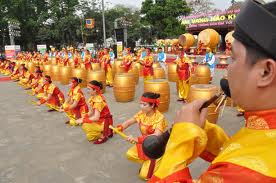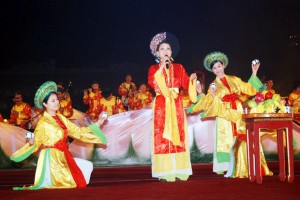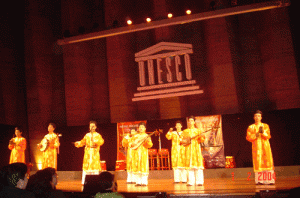“The court music” is normally understood as types of music, including other music types served with dance and opera, used in worship rituals and in the imperial court, in national festivals which the imperial court organized entertainments for the king and royal families. Regarding the name “Nhã Nhạc”, it carried different meanings under feudal dynasties in Vietnam. Sometimes, it meant court music in general, music feast in particular; sometimes it related to music organization, even a certain orchestra.
The Vietnam court music has been officially developed under Nguyen dynasty since early 19th century. However, the foundation of the court music started from 17th century under Nguyen dynasty when the lord moved to the South of Vietnam. The most prosperous time of the court music was in early 19th century under King Tu Duc (1848-1883). In period 1947-1948, the queen Tu Cung (mother of the King Bao Dai, wife of the King Khai Dinh) gathered some artisans of the court music under the king Bao Dai, thanks to her work, some kinds of court music and dance have been maintained. In 80s of 20th century, the Hue court music started attracting the attention of Cultural department and local government. In 90s, the Hue court music stepped on renaissance period. From then to now, this kind of music has been introduced to a lot of countries in the world.
The Hue court music types include worship music feast and music of imperial court rituals, court dance, and court opera.
In the past, the Hue court included a variety of kinds: court music used to Te Giao ritual; temple music for the temple rituals; five music types for sacrifice rituals of the Divine Farmer, the city God; dynasty music for big festivals or for welcoming officers from foreign countries; party music for big parties in the court.
In the past, the Hue court dance had various dances on each special occasion. The 11 court dances remained until now are composed of Bat Dat (used in Giao, Mieu, Xa Tac, historical kings and Confucius worshipping ceremonies); Luc cung, Tam tinh, Bat tien, Dau Chien thang Phat, Tu Linh, Tam quoc Tay Du (used in van tho – King’s birthday, thanh tho – birthday of King’s mother, tien tho – birthday of Hoang Thai Phi (the imperial concubine of King’s late father) and the Mu (a Fairy or Guardian angel) worshipping ceremonies); and thien xuan (birthday of the prince – the successor to the throne); Trinh tuong tap khanh (used in tu, ngu tuan dai khanh ceremonies for wealthy people and powerful country; Nu tuong xuat quan (used on the Days of Victory, Nguyen Dynasty Enthroning Day, lunar – calendar May 2nd, at great night banquets and receptions of foreign ambassadors); Vu phien (devoted to the King’s Mother, wife, ladies-in-waiting, princesses at weddings); Luc triet hoa ma dang (on Nguyen Dynasty Enthroning Day for the watching of the people masses in the front of Phu Van Lau).
Hue Court Music is the last vestige of Vietnamese Court Music. It contains all quintessence of Vietnamese Court Music trend that has been established and developed over 1,000 years, therefore Hue Court Music is identical with Vietnamese Court Music.
At the official meeting of the World Heritage Committee (WHC) in Paris, Nha nhac, Vietnamese Court Music, that Hue has preserved so long, was officially listed by UNESCO among masterpieces of the Oral and intangible heritage of humanity on 7th November 2003. This is the first intangible heritage of Vietnam ever listed in this list, recognized the achievements of 10-year process of striving, tireless preparation of the central, local governments and the Hue Monuments Conservation Centre.
Vietnam warmly welcomes you to enjoy Vietnamese cuisine and to make your trip in smooth water, turn your plan into real by quick hands to obtain Vietnam visa at http://govietnamvisa.com and for Vietnam eTicket at http://vietnamairlines247.com.
For your memorable travel, it is convenient to book tour at http://govietnamtour.net
For your great stay and nice relaxation after a long trip, it is nothing better than booking hotel at http://govietnamhotel.com



